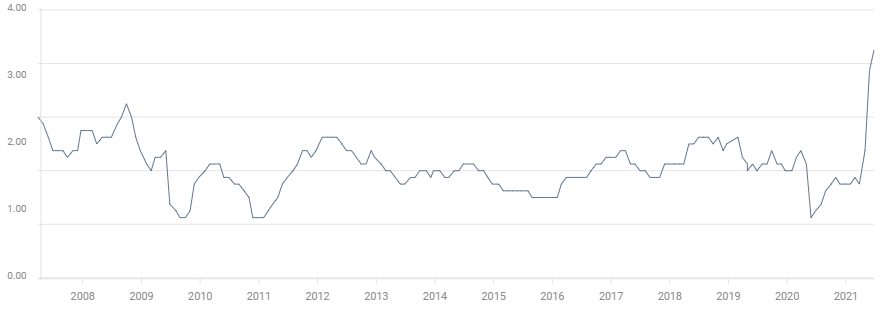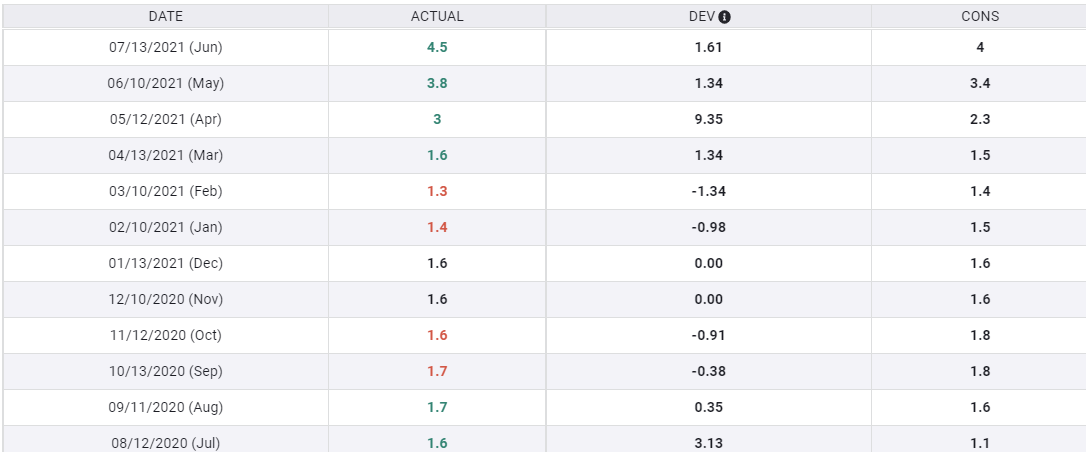- June PCE and Core PCE inflation likely to outstrip predictions.
- CPI and Core CPI were 0.5% over forecasts.
- Inflation pressures from labor market and supply chain dislocations unabated.
- Federal Reserve retains accommodative policy while acknowledging price increases.
- Markets likely to pass on inflation figures after the Fed decisions.
Inflation is rampant. Consumers, politicians, and economists have noticed. Even the Federal Reserve has concerns, though not enough to modify the easy money policy that is abetting the increases.
The Fed’s chosen price gauge, the Core Personal Consumption Expenditure Price Index, core PCE for short, reached a three decade high at 3.4% in June,
Federal Reserve Chair Jerome Powell asserted the central bank position that the inflation surge this year is due to temporary factors at his press conference yesterday after the FOMC decision to leave rates and the bond purchase program untouched. But he admitted that price increases have been stronger than the Fed expected and may last longer than anticipated.
How much longer can the governors avoid action? Next year is an election year. Raging inflation is political dynamite and Chair Jerome Powell’s term is up in February 2021.
The annual Core PCE Price Index is expected to rise to 3.7% in June from 3.4% in May. On the month, price gains are estimated to be 0.6% in June after May's 0.5% increase. Headline PCE rose 0.4% in May and the yearly rate was 3.9%.
Core PCE
PCE and CPI
The Consumer Price Index (CPI) is the elder cousin of PCE. Their statistical methods are similar. The chief differences lie in the basket of items used to assess price changes.
When prices rise consumers often switch purchases to lower cost goods, think store brands rather than name brands. This substitution is included in PCE but not in CPI. Historically, PCE has produced a lower overall inflation rate than CPI.
Core CPI
Core CPI rose to 4.5% in June from 3.8%, for the highest price gains since November 1991. The inflation measured by this gauge has more than tripled from January’s 1.4%.
For the last three months, April, May and June, the actual annual rate has averaged over 0.5% more than the consensus estimate. In the previous quarter the difference between the estimates and result was 0.1%, with two out of three forecasts higher than the actual figure.
The discrepancy between the core PCE estimate and the released figures over the last six months is just 0.08%. The Consumer Price Index from the Department of Labor is issued two weeks before the PCE measure from the Bureau of Economic Analysis. The delay gives economists time to rework their PCE forecast in light of the new information.
Conclusion: Inflation and Fed action
Accelerating inflation has Fed and market attention. Mr. Powell was questioned more extensively on this topic and the possible Fed response than any other at Wednesday’s new conference.
Labor and supply shortages have not abated and Mr. Powell acknowledged that they may continue for longer than the central bank had anticipated.
Congress will at some point pass another enormous deficit package adding more monetary fuel to the economy.
The Fed has been successful at thwarting the higher Treasury rates that would be the normal effect of this inflationary surge. The yield on the benchmark 10-year bond has fallen more than 25 basis points since the June 16 FOMC. The dollar has strengthened modestly as the US remains the best bet for a robust economic recovery.
Market reaction to the June PCE figures, historic as they may be, will be limited, the Fed has seen to that. But the central bank’s position that inflation is a temporary phenomenon will be tested in the next few months. The prognosis is doubtful.
Information on these pages contains forward-looking statements that involve risks and uncertainties. Markets and instruments profiled on this page are for informational purposes only and should not in any way come across as a recommendation to buy or sell in these assets. You should do your own thorough research before making any investment decisions. FXStreet does not in any way guarantee that this information is free from mistakes, errors, or material misstatements. It also does not guarantee that this information is of a timely nature. Investing in Open Markets involves a great deal of risk, including the loss of all or a portion of your investment, as well as emotional distress. All risks, losses and costs associated with investing, including total loss of principal, are your responsibility. The views and opinions expressed in this article are those of the authors and do not necessarily reflect the official policy or position of FXStreet nor its advertisers. The author will not be held responsible for information that is found at the end of links posted on this page.
If not otherwise explicitly mentioned in the body of the article, at the time of writing, the author has no position in any stock mentioned in this article and no business relationship with any company mentioned. The author has not received compensation for writing this article, other than from FXStreet.
FXStreet and the author do not provide personalized recommendations. The author makes no representations as to the accuracy, completeness, or suitability of this information. FXStreet and the author will not be liable for any errors, omissions or any losses, injuries or damages arising from this information and its display or use. Errors and omissions excepted.
The author and FXStreet are not registered investment advisors and nothing in this article is intended to be investment advice.
Recommended Content
Editors’ Picks

EUR/USD stays near 1.0400 in thin holiday trading
EUR/USD trades with mild losses near 1.0400 on Tuesday. The expectation that the US Federal Reserve will deliver fewer rate cuts in 2025 provides some support for the US Dollar. Trading volumes are likely to remain low heading into the Christmas break.

GBP/USD struggles to find direction, holds steady near 1.2550
GBP/USD consolidates in a range at around 1.2550 on Tuesday after closing in negative territory on Monday. The US Dollar preserves its strength and makes it difficult for the pair to gain traction as trading conditions thin out on Christmas Eve.

Gold holds above $2,600, bulls non-committed on hawkish Fed outlook
Gold trades in a narrow channel above $2,600 on Tuesday, albeit lacking strong follow-through buying. Geopolitical tensions and trade war fears lend support to the safe-haven XAU/USD, while the Fed’s hawkish shift acts as a tailwind for the USD and caps the precious metal.

IRS says crypto staking should be taxed in response to lawsuit
In a filing on Monday, the US International Revenue Service stated that the rewards gotten from staking cryptocurrencies should be taxed, responding to a lawsuit from couple Joshua and Jessica Jarrett.

2025 outlook: What is next for developed economies and currencies?
As the door closes in 2024, and while the year feels like it has passed in the blink of an eye, a lot has happened. If I had to summarise it all in four words, it would be: ‘a year of surprises’.

Best Forex Brokers with Low Spreads
VERIFIED Low spreads are crucial for reducing trading costs. Explore top Forex brokers offering competitive spreads and high leverage. Compare options for EUR/USD, GBP/USD, USD/JPY, and Gold.

